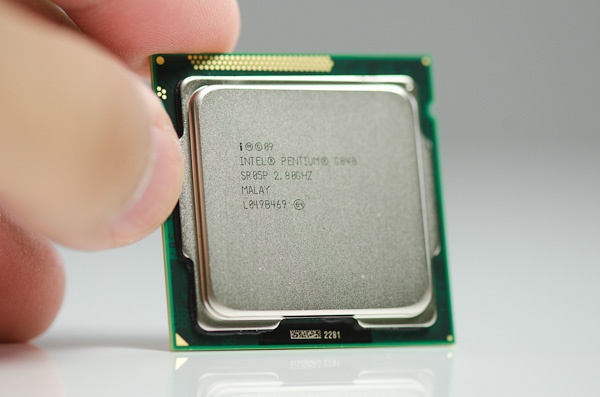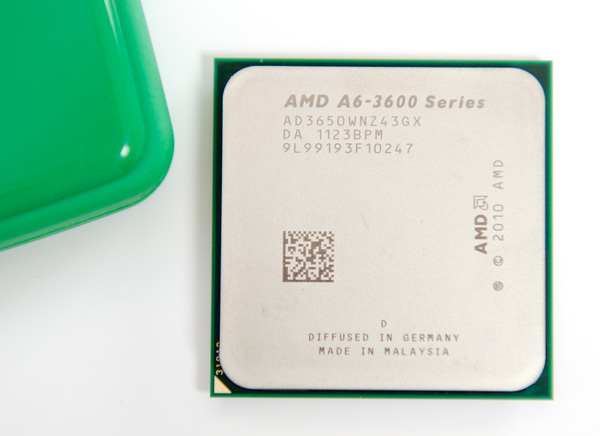The Sandy Bridge Pentium Review: G850, G840, G620 & G620T Tested
by Anand Lal Shimpi on August 23, 2011 12:11 AM ESTFinal Words
Despite boasting Intel's latest Sandy Bridge microarchitecture, the conclusions here are pretty much unchanged from the past. Intel maintains an advantage when it goes up against an AMD chip with the same number of cores, almost regardless of clock speed. In the case of the Pentium G620, even an Athlon II X2 265 with a 27% clock speed advantage can't outperform the Sandy Bridge based CPU. If you're choosing between chips with the same number of cores at the same price, Intel wins.
The decision tilts in AMD's favor if you start comparing to the Athlon II X3. In heavily threaded workloads, the Athlon II X3's third core helps put it ahead of the entire SNB Pentium lineup. If you're building a machine to do offline 3D rendering, multithreaded compiling or video transcoding then AMD continues to deliver the best performance per dollar. It's in the lighter, less threaded workloads that the Pentium pulls ahead. If you're building more of a general use system (email, web browsing, typical office applications and even discrete GPU gaming), the Pentium will likely deliver better performance thanks to its ILP advantages. What AMD has offered these past couple of years is an affordable way to get great multithreaded performance for those applications that need it.
Unfortunately the entire Sandy Bridge Pentium lineup is clock locked. Without turbo modes there's no support for overclocking at all. While these new Pentiums would have normally been great for enthusiasts looking to overclock, Intel has ensured that anyone looking to get more performance for free at the low end will have to shop AMD. Unfortunately Intel's advantage in single/lightly threaded performance is big enough that a clock speed advantage alone is generally not enough to make up for it (see G620 vs. Athlon II X2 265 comparison). It's sad that it has come to this. I was hoping we'd see more K-series SKUs at the low end but it seems like those will only be for the enthusiasts at the high end.
The Pentium's on-die GPU isn't particularly impressive. It's the HD Graphics 2000 from the rest of the Sandy Bridge lineup without Quick Sync or any of the extra video features. I am particularly sad that Quick Sync is missing as it would've made these Pentiums extremely attractive for users that do a lot of video transcoding. Thankfully video decode acceleration and HD audio bitstreaming support remain, so if you're looking to build a cheap Sandy Bridge based HTPC and don't care about the frills these chips will work just fine.
However, if you're building a system to do any sort of 3D gaming you're much better off either springing for a cheap discrete card or looking at AMD's A6-3650 if you want to stay integrated. Although you can play older titles at low resolution on the Pentium's on-board GPU, you'll have a much better experience with a discrete GPU or with the A6.
It all boils down to this. If you want a good, cheap, general purpose PC then the Pentium G620 seems competent and cheap. You can consider the G840 if you want a bit more performance. If you do a lot of threaded work (e.g. offline 3D rendering) the next step up is the Athlon II X3 455. If you do any amount of consumer level video transcoding using apps that are Quick Sync enabled, opt for the Core i3 2100 instead. If gaming is important to you then either buy a discrete GPU or look to AMD's Llano.
As far as AMD's A6 vs. A8 goes, the A8-3850 only commands a $20 price premium over the A6-3650. That $20 gives you another 8 - 10% on the CPU side and around 20% on the GPU. In my opinion, if you're considering a Llano system - spring for the A8.












110 Comments
View All Comments
dingetje - Tuesday, August 23, 2011 - link
AMD Athlon II X3 455 = 80 bucksIntel G620 = 78 bucks
nuff said
kmmatney - Tuesday, August 23, 2011 - link
You can overclock the AMD processor, though. You can get an Athlon X2 560 black edition, plus a motherboard for $89 at Microcenter (and the last one I bought unlocked to 4 cores). The Phenom II processors can often be had for low prices - they should have included at least one Phenom II in the benchmarks.dingetje - Tuesday, August 23, 2011 - link
lol, with nuff said i meant:they are priced the same and with 3 overclockable cores the AMD is way better deal
ET - Tuesday, August 23, 2011 - link
As you can see, it's apparently not obvious that's the better deal. I agree the AMD is better for enthusiasts. It's worse for people who care about power consumption, and it will be worse for gaming (though perhaps not significantly so if you use an inexpensive GPU).yankeeDDL - Tuesday, August 23, 2011 - link
ET, there's a "Best gaming CPU for the money" article on Tom's hardware: go and see that every CPU up to the Core i5 2400 is AMD.This translates into: if you are into gaming on a budget, there's only one choice.
I agree on your comment on power efficiency: Intel is unrivaled and if your highest priority is power consumption, then the Pentiums are unbeatable.
Of course, the differences measured, are completely irrelevant in a home environment: it may make a difference of $3, $4 in one year, if even. The only place this would really matter to the point that it could be a priority, is for large enterprises. Then again, this is not the entry-level PC for Mr Joe Average.
It is absolutely normal for Intel to use its brand name to charge more, for inferior products. I'm sure AMD would do the same if could. This doesn't change the fact though that if you're after getting the most for your hard earned $$$, if you're after the best price/performance ratio, you cannot possibly choose Intel.
frozentundra123456 - Tuesday, August 23, 2011 - link
I think you had better re-read that chart, yankee, or look at toms today and see the new chart. Intel is well represented all the way to the lowest level:85.00: Athlon II x3 455
100.00: Tie, Phenom II x4 840, Pentium G850
125.00: i3 2100
190.00: i5 2400
220.00: i5 2500K
325.00: i7 2600K
I didnt include an "honorable mention" because the article is "best for the money" but at 120.00 AMD did have an honorable mention for one of the quad core phenoms.
But if you only look at the clear winning categories 125.00 and under, AMD has 2 and intel has 2.
above 125.00 it is all intel. So if you are gaming on a budget, you do have a choice. Intel is tied or ahead except at the very lowest price point.
yankeeDDL - Wednesday, August 24, 2011 - link
Hi Frozentundr,I have read the article very well and what you wrote confirms this exactly: like I said, if you're looking for gaming on a budget, you look at the cheapest CPUs that give you the best "bang" for the bucks.
If you read the comment about the G850: "However, it only offers half of the execution cores as AMD's alternative, and it doesn't even have the Hyper-Threading technology needed to logically address four threads".
Translated: you save on power, but the G850 can be set to choke much easier than a Phenom II X4. I hope you would agree.
You're right about the Core i3: I skipped it when posting my note, but the conclusion totally stands: the lowest priced gaming CPU worth recommending, are AMD.
The Core i3 is an option indeed if you're willing to spend some more on CPU, motherboard, and forsake overclocking as well, but we are already talking about a CPU more than 50% more costly than the Athlon II X3, so calling it "entry level" would be a bit of a stretch.
frozentundra123456 - Wednesday, August 24, 2011 - link
All I was saying is that your original statement was not correct. Intel does have processers listed in the lower end. Now it seems you are changing the conditions of the argument to make your point. You are talking about only the "absolute lowest" price. And as every AMD fan eventually brings up, you can get more cores.Personally, I would even agree with you that I probably would prefer a quad core AMD to a Pentium for sure, maybe even to the i3 2100. But that is not the point. The point is that Intel does have competitive processors in the low end, based on what Tom's said, not on my evaluation.
And I would consider the difference between an 80.00 and 125.00 processor not that significant. I mean, that is the price of one game, or one dinner out for a couple of people.
Bottom line, I dont see how you can call intel processors "overpriced rubbish" based on Toms article. And I am not an intel fan. My first real gaming was done on a single core Athlon XP 2600, but I am just getting tired of AMD continuing to push out CPUs using an outdated architecture.
ypsylon - Tuesday, August 23, 2011 - link
Well I want to build super-duper cheap m-ATX/ITX PC. That slowest of them,G620T, running at 2.2 GHz looks like a good deal. 35W is great when you look at modern CPUs. Perfect for small box which will do trivial task like recording audio tracks or downloading torrents through the night. All of that with min. power drain. And most important thing all of those Pentiums are not as useless as Atoms. What is nice in Atoms [and likes] is only power drain, but performance is highly insufficient even for many trivial jobs. I don't need OC, well to be honest I would love to see VT-d, but heck you can always install XP (it still alive and kicking, and I couldn't care less about M$ propaganda) only or Linux!One thing which I'm not too sure about is the testing procedure. Those CPUs are not targeted at gaming or video editing.
Captmorgan09 - Tuesday, August 23, 2011 - link
I built up a WHS box running a G620T along with 4GB of RAM and 4 1.5TB WD black edition drives in RAID 5. It's not the speediest machine in the block but it runs cool and does the job. The only issue I had was the asus board I bought didn't support the G620T out of the box. Had to take the board to work and use an i5 so that I could boot and update the BIOS.